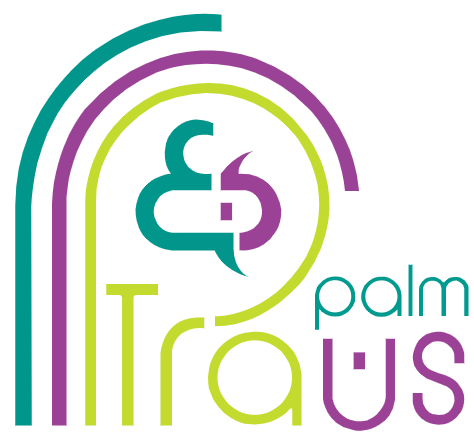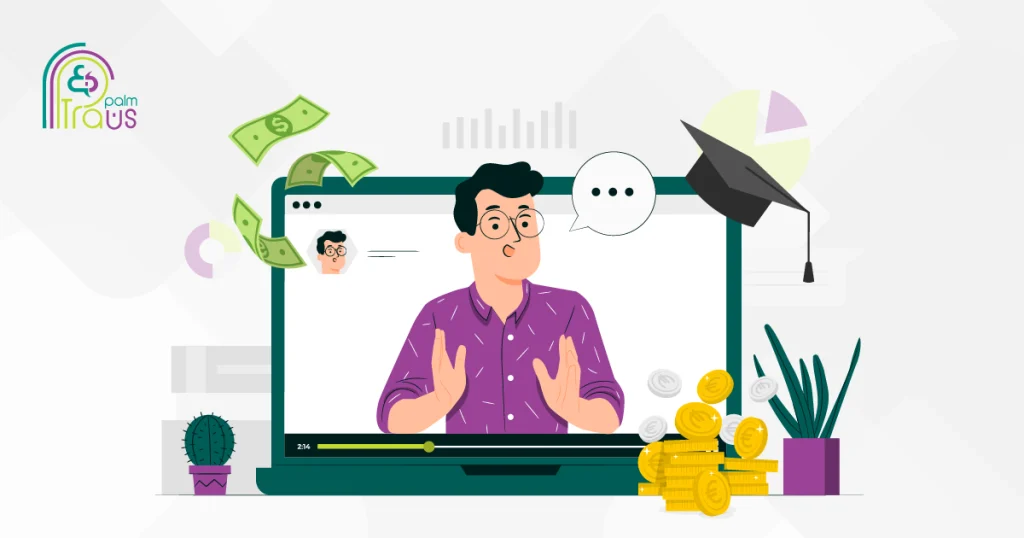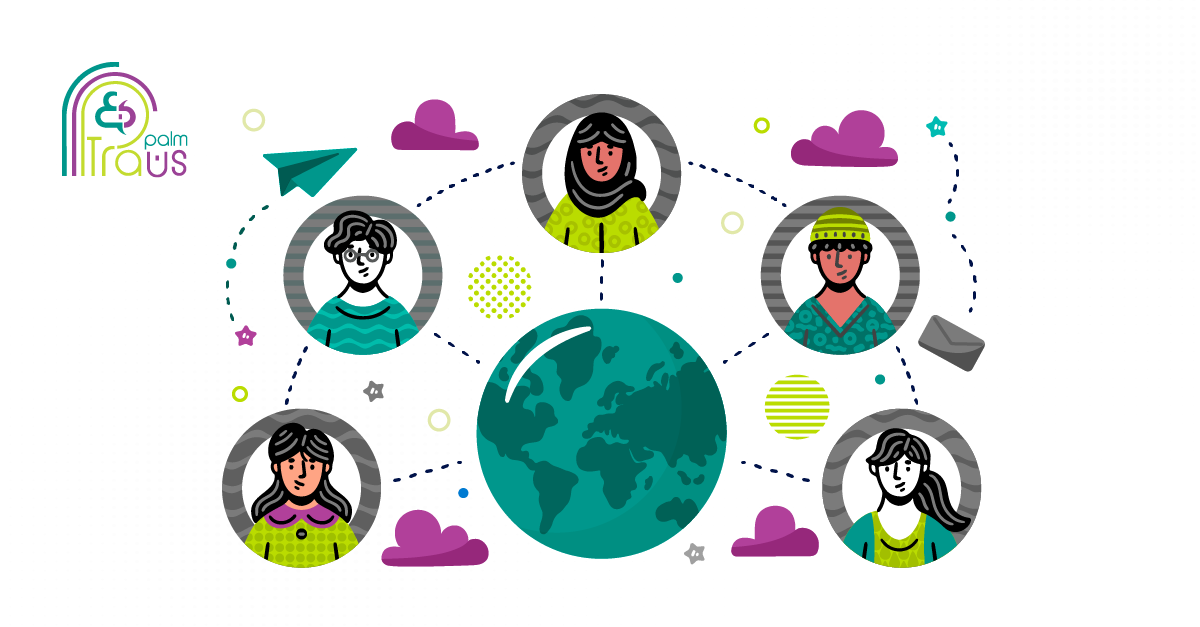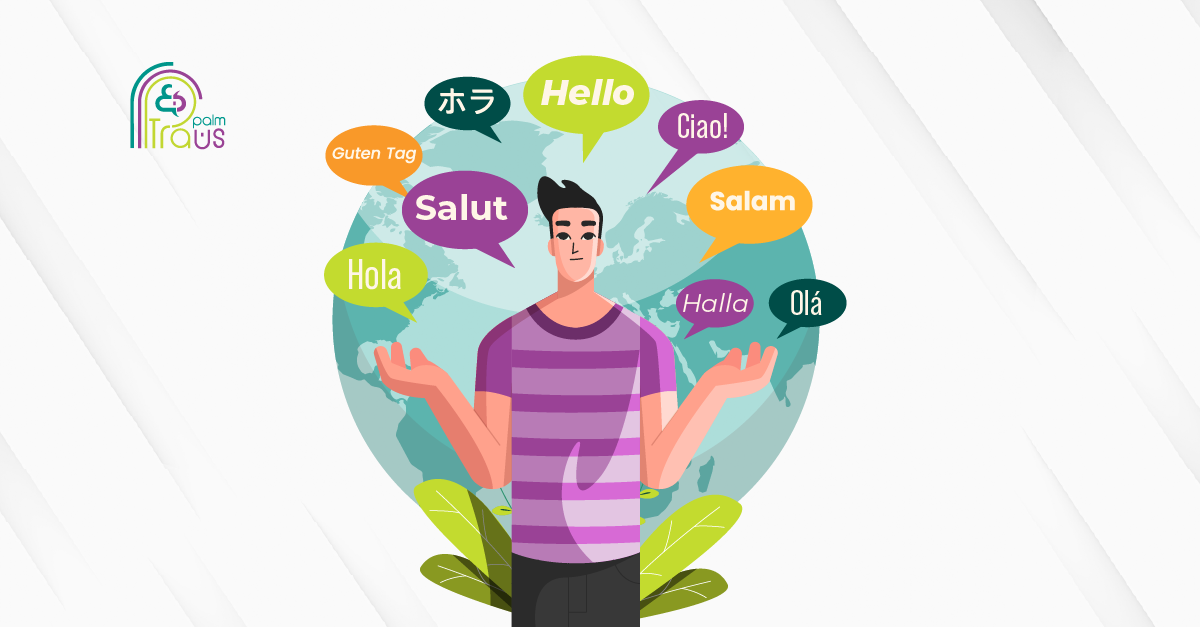If your e-learning course has the potential to reach a global audience, localizing it is a smart move.
It can help expand your student base and boost course revenue. But how do you set an accurate quote for eLearning localization? The costs can vary based on factors. In this guide, we’ll explore what impacts pricing and how to manage these elements effectively to get the best value for your localization project.
Let’s get started!
What is eLearning Content Localization?
eLearning content localization starts with translation from one language to another but goes much further, involving the adaptation of formatting, media, interactivity, and layout to suit particular audiences.
Consider post-translation engineering, which includes elements like font choices, text direction (LTR vs. RTL), audio sync, and device compatibility across different scripts to verify that everything functions and looks right after localization.
Key Factors That Impact eLearning Localization Quotes
E-learning authoring tools may differ in some aspects, but most share the same fundamental features. If you want to learn how to budget for localizing e-learning courses, consider the following common factors that can apply to any tool for creating online courses.
A. Number of Scenarios
Type (1): Final Exams
A test at the end of the course evaluates learners’ understanding of the content, with pass or fail outcomes based on performance. Therefore, you will need to test it twice in each language: once for the correct answers and once for the incorrect answers.
Type (2): Conditional Scenarios and Branching
Multiple learning paths, chapters, and levels increase the complexity of the project, so the quote must cover all possible outcomes or scenarios, not just the ideal ones where learners succeed and everything goes right.
Slides and Layers
1) Types of Slides:
- Static slides contain only an image and text, with no animation. This type is simple and requires less time for engineering.
- Animated slides feature animated text and interactive buttons. They are complex and demand more time for integration and synchronization.
2) Types of Layers:
- Text layers may need to be synchronized with elements such as audio or animation.
- Non-text layers do not require synchronization, so they are not considered when estimating the time for engineering.
3) Complexity Hierarchy
Not all slides demand the same amount of engineering work. While some slides are quick to process, others take more effort and time.
The list below is arranged from the simplest to the most complex to help you better understand how slide complexity increases.
- Static slide without layers
- Static slide with layers
- Static slide with audio
- Static slide with audio synchronized with text
- Animated slide
- Animated slide with layers
- Animated slide with audio and text synchronized
- Animated slide with multi-layered text and audio synchronized
C. Graphics
1. Graphics for Content Enrichment
They do not contain any text or information that requires localization, and they enhance the overall look and feel of the content.
2. Bitmap Graphics for Illustrative Purposes
These graphics involve visuals with text to support or explain concepts that need localization.to keep consistency across languages.
3. Software or Demo Screenshots
They are actual software interfaces or demo screenshots, so you need to ask the client whether they want to localize, retake, or keep them as in the source.
D. Interactive Elements
Quiz questions, audios, videos, subtitles, and closed captions are considered interactive elements.
You should add them to the quote after a thorough analysis, and include items that will need localization.
There are two main types of quiz questions: one type appears at the end of each scenario or after a specific number of slides, while the other type consists of independent quiz scenarios that are separate from the main content.
E. Resources and Glossaries
Resources are the external files attached or embedded in the course. They can be in Word, PDF, Excel, or any other format. These should be taken into consideration in the quoting process for both translation and engineering. If you have a glossary, you must take into account that it will need to be sorted according to the target language.
F. Key Engineering Aspects
All the above factors are the main factors to consider in the process of quoting for the eLearning course post-translation engineering (DTP). There are three more factors to consider:
1. Language Contraction or Expansion
We mostly consider language expansion, but sometimes language contraction can cause serious problems because it may require shrinking the timeline too much, especially if there are audios. For example, in Chinese, if you have audio synchronized with text, the timeline will shrink, and you may need extra work to slow the speed and give the user enough time to cover all the course content.
2. Direction and RTL issues
None of the authoring tools support RTL direction reverse layout. Tools like Lectora and Captivate only support RTL languages, not the direction. Therefore, you need to consider the issues that may occur and report them.
3. Need to Change Source Fonts
Consider the need to change the source fonts to match the target language character set, as this may be a manual process in some tools.
Authoring Tool-Specific Quoting: A How-To Guide
Adobe Captivate
Here are the main factors that can impact your quote:
- UI Complexity: The interface is more complicated than other authoring tools, so it may take more time.
- Different Layering System: You need to check how layers work in your project before quoting.
- Responsive Design: Designing for different screen sizes adds complexity.
- RTL Languages: You may require extra help from a developer or HTML expert for languages like Arabic or Hebrew.
Lectora Inspire
Here’s what you need to keep in mind:
- HTML Concept: Based on HTML, so what you see in the tool is not always what you get in the final output.
- Multiple Text Layers: One slide may have several text layers, so you must check them carefully to include in the quote.
- Testing: You will need to check each slide individually, and this adds to the total engineering time.
- RTL Languages: Similar to Captivate, RTL languages may need help from a developer or HTML expert.
- Responsive Views: Lectora’s responsive design also adds complexity and needs to be tested across different devices.
Lectora Online
Lectora Online is similar to Lectora Inspire, but it works online. Here’s what makes it different:
- HTML-Based: What you see in the tool isn’t always what you get in the final output.
- Multiple Text Layers: A single slide often contains several text layers, so it’s important to review each one carefully for accurate inclusion in the quote.
- Page-by-Page Testing: Unlike Lectora Inspire, you need to check each page instead of just slides.
- Internet Connection: Since Lectora Online is cloud-based, your internet speed can affect your work efficiency.
- RTL Language Support: RTL issues often require a developer or HTML expert touch.
- Responsive views: It increases the complexity of the file, so this should be considered when providing a quote.
Pro Tips for Analyzing and Scoping eLearning Files
- Layer and Slide Counting ➔ Exclude the base layer and count only text layers. Divide text layers by 4, then add that to the original slide count. For example, if there are 20 slides with 20 text layers, the total number of slides will be 25 for the quote.
- Media Inclusion Logic ➔ Only count media with speech (audio/video with text or voice-over). Exclude media without speech.
- Analyze the File by Item, not by Slide ➔ Estimated by items, sections, and modules for more accurate pricing.
- Stress Reduction Tip ➔Quoting for e-learning can be boring, especially if the course is complex. Take a short break when reviewing to avoid burnout and provide accurate outcomes.
Avoid These 6 Common Pricing Myths in Localizing eLearning Courses
What you were told before is wrong! Setting the right price for adapting your online courses does not have to be a guessing game. With too many factors to consider, it can be challenging to know where to start. Some common misconceptions about course pricing might trip you up, but once you spot them, you will be back on track. Let’s tackle a few of these myths to avoid falling behind.
Myth #1: Your Course Can Be Priced Based on Word Count
Basing the cost solely on the word count of the course content isn’t enough. Cultural adaptation in eLearning is not just text-based; it involves visual elements, audio narrations, interactive components, and sometimes custom-built features. All of these aspects should be factored into the pricing, as they impact the overall scope and cost of the project.
Myth #2: eLearning Pricing Relies on the Number of Slides
Some slides are simpler and less time-consuming, while others may include embedded videos, images, animations, or interactive elements. Therefore, the cost should be determined by the complexity of the slides. For example, a single slide with an animated video requires more effort than a slide with simple text and images.
Myth #3: eLearning Can Be Quoted by Viewing Only the Published Version
The published version of an e-learning course is the “end product.” However, you should not rely on it when setting the price, as it hides the structure, layers, scripts, and media assets created by developers and designers during the process.
Accurate quotes require access to source files, such as Storyline, Captivate, or other e-learning localization tools. These source files reveal all the hidden components that may affect time and cost.
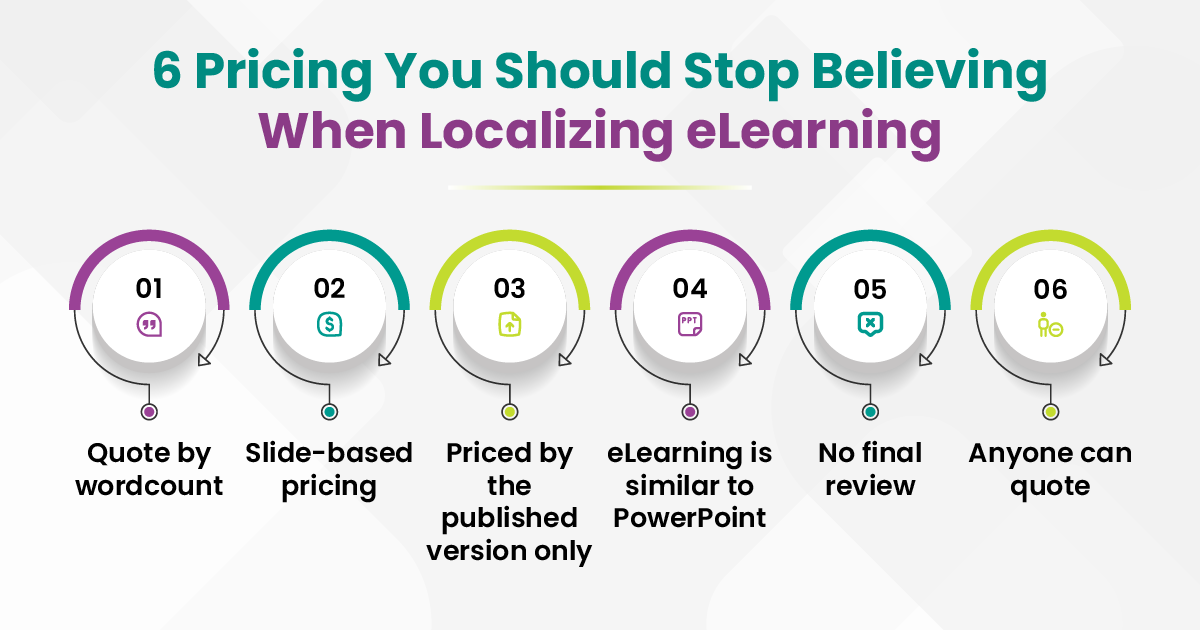
Myth #4: eLearning Resembles PowerPoint in Capabilities
While PowerPoint can create slide decks or slideshows, e-learning includes interactive features such as simulations, voice-overs, quizzes, assessments, branching scenarios, and more that PowerPoint cannot handle. Unlike PowerPoint, e-learning requires graphic design, multimedia production, and programming, so these factors should be reflected in the pricing strategy.
Myth #5: Final Files Don’t Require a Review
You may think the end product does not need a final check, but overlooking this step could negatively influence the learning experience. Reviewing the final file version guarantees everything was implemented correctly, from navigation to synchronization between audio and visuals. But how is it related to pricing? Errors or mistakes can lead to rework, which adds extra time and increases costs.
Myth #6: Anyone Can Quote for eLearning
Estimating the right price for elearning content localization is not simple. These projects require skilled professionals with expertise in e-learning localization tools, LMS localization, instructional design, multimedia production, cultural nuances, and technical aspects. Accordingly, working with a partner who knows the intricacies of eLearning will save you time and resources in the long run.
Best Practices Before Setting Prices for eLearning Content Localization
✔ Read the client’s brief and focus on details.
✔ Ask questions to clients, and avoid making assumptions.
✔ Publish the course first to review how the final output looks before estimating the quote.
✔ Open and assess the working file to understand the scope of the project.
✔ Always think from the client’s perspective.
✔ Take notes and record every decision.
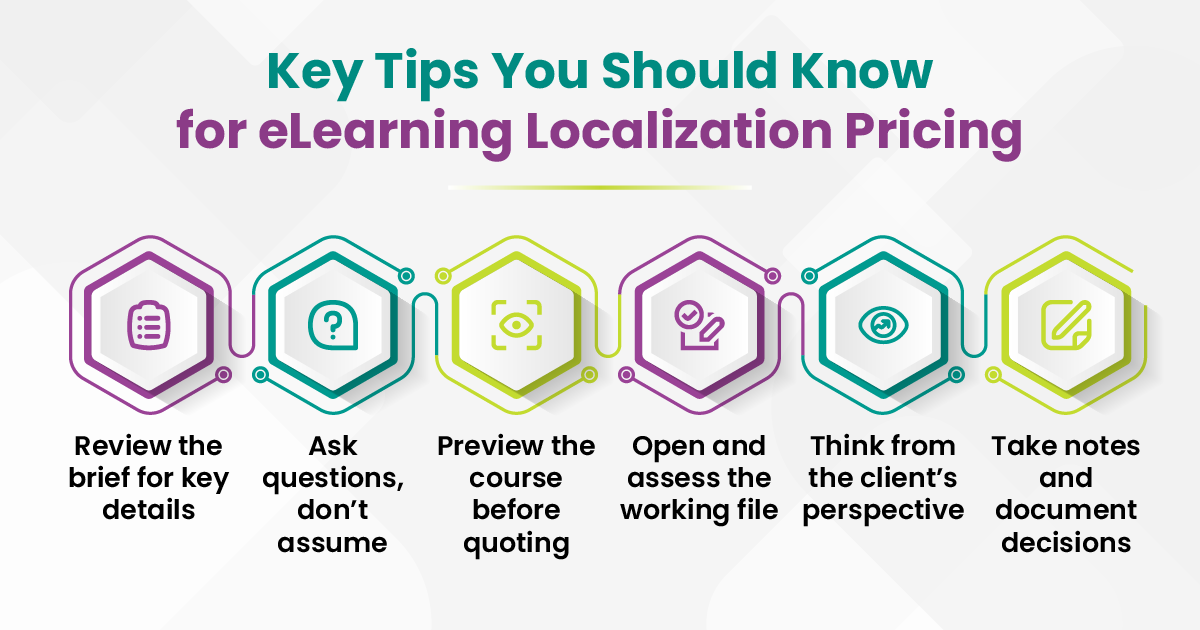
Request a Quote for Your Next E-Learning Localization Project with TransPalm
TransPalm is here to help you with precise localization. Book a consultation today, and let’s work together to ensure your materials are perfectly adapted for your global audience. Get your quote now and let’s get started!
